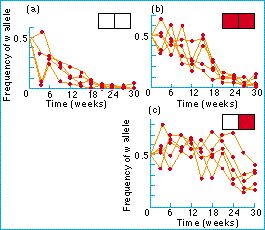Multiple niche experiment

Normal individual fruitflies (Drosophila) have orangy-red colored eyes. In some mutant forms, however, the red pigment is lacking and their eyes are white. These eye color mutations affect the fruitfly's response to light. A normal Drosophila, with red eyes, is attracted to light, though repelled by very bright light; white-eyed mutants are more sensitive and (if given the choice) will settle in places of lower light intensity.
Jones and Probert performed the following experiment with normal and white-eyed Drosophila simulans :
They set up cages, with a mixture of the two genotypes, in either white or red light; in both cases the white-eyed mutants were at a disadvantage and selection reduced their frequency. Jones and Probert also placed the two types of fly together in a cage that was illuminated with red light in one half and white light in the other half. In this case the two genotypes were maintained. Also, as you would expect, the white-eyed flies concentrated in the red half of the cage, and the normal red-eyed flies in the half with white light; the flies show 'habitat selection'.
The polymorphism in the cage with both white and red light is a multiple niche polymorphism, a topic first discussed by Levene in 1953. We can think of the parts of the cage with differing illumination as different 'niches', analogous to distinct regions in the species' natural environment. When both red and white niches are present, each type of fly chooses to live in the type of niche where it has higher fitness. The result is for normal flies to go to the region with white light, leaving enough resources for the white-eyed mutants to survive where the light is red.
Figure: selection between normal and white-eyed genotypes of Drosophila simulans in three types of environment. In white light (a) the white-eyed genotype is removed by selection, as it is in red light (b). But when the flies are placed in cages with red and white light, both genotypes persist (c). In each case, the population was started with a mixture of the two genotypes, and the graphs plot the change in frequency of the white-eyed genotype. From Jones and Probert (1980).
| Next |



